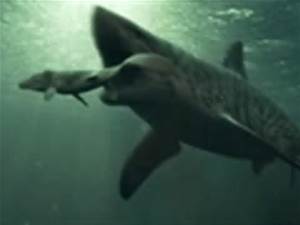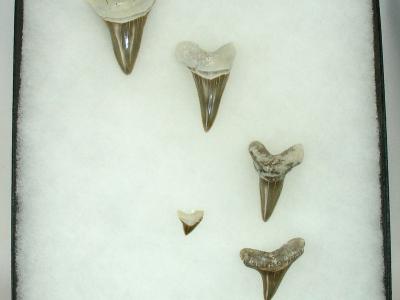Giant Sharks Through Time



Great Whites are currently the largest predator shark on this water planet, but it hasn’t always been this way. The first large predator shark dates back to 100 million years ago back to the Cretaceous period of time. The shark I am referring to is Cretoxyrhina manteli, which is commonly known as the Ginsu shark because of its sharp ginsu knife slice and dice teeth. The teeth were large, sharp, and had smooth edges similar to the modern short fin mako shark. This large lamniform shark grew 20-24ft long and preyed on fish such as the 20ft long fanged tooth Xiphactinus, Plesiosaurs such as elasmosaurus, mosasaurs, and archelon turtles. Remains of sea going reptiles such as Mosasaurs have been found inside the stomachs of fossilized Ginsu sharks, Ginsu teeth marks have been found on fossils of Mosasaurs, and half digested fossilized remains of smaller Mosasaurs bones have been found near Ginsu shark deposits. Ginsu sharks died out some 82 million years ago and this could be partly due to the fact that certain species of mosasaurs grew close to 50ft long and in turn became the top predator of the time. Whether Mosasaurs ate all the Ginsu sharks, dominated the former Ginsu shark food supply, food sources like Xiphactinus fish diminished, or the rising number of other predators proved overwhelming, Ginzu sharks managed to survive for 18million years and just like the warm waters of the Thethys Ocean, Ginsu Sharks ultimately became extinct.



For the next 54 million years a few early species of mako sharks radiated in to sharks 20 to 30ft long sharks such as Paratodus benedeni, Isurus hastalis, and Isurus estheri, but 28 million years ago during the Oligocene a new large species of shark came to light and pushed these mako sharks out of sight and out of mind. It was a time when whales dominated the seas and radiated into many species. The new shark Carcharocles megalodon or simply Megalodon, which grew to some 43 to 52 plus feet in length, roamed the warm waters in search of big fish and whale buffets. Remnant fossilized teeth over seven inches long are still found on the muddy bottoms of rivers in South Carolina and Florida as well as off shore along the south eastern states.



An intermediary 16ft long form of broad tooth mako shark with coarse serrations on its teeth and similar to great white teeth was found in 6.5 million year old fossil deposits of Peru. Scientist are now confident that the great white took it’s current form from ancestors of serrated tooth mako during the early Pliocene 4-4.5 million years ago along the Pacific Coast where whales and seals are still quite prevalent. In the late Pliocene around 2-2.5 million years ago great whites radiated out to other parts of the world. Megalodon sharks finally died out 1.8million years ago, giving them a total life long run of almost 26 million years on this water planet. It’s not known if great whites lead to the extinction of Megalodon sharks, but juvenile megalodons with butter knife smooth teeth would have had to compete directly against easy chomping great whites with steak knife teeth. The sharp teeth would come in handy against seals, and may have given great whites an edge on hunting young whales too. It’s also known that species of giant mako sharks became extinct as great whites filled the niches of the precursor instead of the mako.



Some fifteen million years ago the cold Antarctic circumpolar current came into existence and by 10 million years ago several species of sharks began to grow in size. By the end of the Pliocene, somewhere around 3 million years ago, the waters became cooler as the Greenland ice cap accumulated. Megalodon fossils are usually associated in areas that were once warmer or tropical. Perhaps the great white by just being able to hunt in colder waters than megalodons and ability to expand out around the world could have eventually reduced the megalodon’s immediate, as well as their migrating food supply, and led to the megalodon’s final extinction.



Millions of sharks are killed yearly and efforts to curtail or eliminate this routine practice must be enhanced. Knowing the evolution of giant sharks, now more than ever, it is important to safe guard the existence of great whites. Because if they went instinct even accidentally, it could take another 25 million years before the world could see such a large top predator, and that is only if the food supply was abundant, over fishing was no longer a threat, and the climate or water temperature was agreeable to a currently unknown future radiated shark species.

Recent Posts
- Eastern Malaysia, Sabah, Sipadan & More
- Ghost Pipefish, Pipefish, Seahorses, and Sea Dragons
- Australia Queensland and the Great Barrier Reef
- Tioman Islands, Malaysia
- The Riviera Maya
- The Peter Diving System
- The Bay Islands, Roatan, Utila, Guanaja, and more.
- The Cuttlefish; The Undisputed Master of Camouflage.
- The Maldives: A Garland of Islands in the Indian Ocean
- Frogfish, The Overlooked Camouflage Artist
Categories
- Australia
- Bahamas
- Bay Islands
- Belize
- Blue Hole
- Bonaire Diving
- Borneo
- Cayman Brac
- Cayman Islands
- Cozumel
- Curacao
- Cuttlefish
- Dive Destinations
- Dive Equipment
- Dive Liveaboards
- Dive Resorts / Properties
- Dive Travel
- Dive Travel Deals
- Diver Wellness
- Dolphins
- Dominica
- Eagle Rays
- eagle rays
- Family Travel
- Fiji
- Galapagos Islands
- Great White Shark cage diving
- Guanaja
- Honduras
- Indonesia
- Infographics
- Isla Mujeres
- Learning to Dive
- Little Cayman
- Maduro Dive Newsletter
- Malaysia
- Maldives
- Manta Rays
- Marine Life
- Mexico
- Micronesia
- Muck Diving
- Myamar
- Palau
- Papua New Guinea
- Pelagics
- Philippines
- Pinnacles
- Polynesia
- Reefs
- Riviera Maya
- Roatan
- Saba
- Sabah
- Scuba Diving
- Scuba Gear Reviews
- Scuba News/Events
- Scuba Training & Education
- Sea Legends
- sea lions
- Sea of Cortez
- Sharks
- Single Travel
- Sipadan
- Socorro Islands
- South Africa
- Specialties
- ST. Kitts
- Stingrays
- Tahiti
- Thailand
- The Bucket List
- Tobago
- Truk Lagoon (Chuuk)
- Turks and Caicos Islands
- Turtles
- Uncategorized
- Underwater Photography
- Underwater Video
- Utila
- Walls
- Whale Sharks
- Whales
- Wreck Diving
- Wrecks
- Yap
Archives
- January 2024
- April 2023
- March 2020
- March 2019
- January 2019
- November 2018
- September 2018
- July 2018
- May 2018
- March 2018
- January 2018
- October 2017
- September 2017
- June 2017
- April 2017
- February 2017
- January 2017
- October 2016
- August 2016
- July 2016
- May 2016
- March 2016
- February 2016
- January 2016
- December 2015
- August 2015
- June 2015
- April 2015
- January 2015
- November 2014
- July 2014
- April 2014
- February 2014
- December 2013
- November 2013
- October 2013
- September 2013
- August 2013
- July 2013
- June 2013
- May 2013
- April 2013
- March 2013
- February 2013
- January 2013
- December 2012
- November 2012
- October 2012
- September 2012
- August 2012
- July 2012
- June 2012
- May 2012
- April 2012












